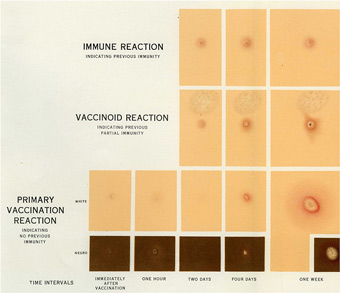Using Advances in Viral Tissue Culture Techniques to Produce a Safer Smallpox Vaccine
In the early 1930s physicians became increasingly aware that the vaccine available for smallpox could lead to inflammation of the brain (encephalitis). The vaccine, made from vaccinia, or cowpox virus, was collected from calf lymph fluid, a source that contained many contaminating cells and proteins. Rockefeller's pioneering virologist Tom Rivers (1888-1962) undertook to develop a safer vaccine by growing the virus in tissue culture. The result was an attenuated strain of virus that did not have side effects or leave a scar after vaccination. Tested in hundreds of children, it was the first vaccine used in humans to be grown in tissue culture.
Ultimately, Rivers and his colleagues concluded that the new vaccine did not provide sufficient protection from smallpox. But the research effort had other important consequences. Rivers' interaction with Rockefeller Foundation scientists, who were then working to make a yellow fever vaccine in Foundation laboratories on the Rockefeller Institute campus, influenced Max Theiler to create an attenuated virus vaccine. Theiler later won a Nobel Prize for this work. In addition, in the 1930s lively debate persisted in the scientific community about whether viruses could grow without the presence of living cells. Rivers used his vaccinia publications to advocate for the position that viruses are obligate parasites, by attempting—and failing—to replicate reports that vaccinia multiplied in cell-free media. Finally, Rivers' research made vaccinia the best-understood animal virus of the day, and the first to be characterized chemically.

The colored records represent a careful selection of the standard types of reactions which follow smallpox vaccination. From Viral and Rickettsial Infection of Man by Rivers, T., 1948
Thomas M. Rivers received the BA from Emory College in 1909 and the MD from The Johns Hopkins University Medical School in 1915. After an internship and residency in pediatrics, he joined the Army in 1918, serving on commissions with the U.S. Army Medical Corps that investigated outbreaks of pneumonia and empyema. He returned to Johns Hopkins for a research appointment in 1919, and joined the Rockefeller Institute Hospital in 1922. In 1937 Rivers became director of the hospital, a position he held until 1953, when he became Vice President and Director of the Institute (Detlev Bronk assumed the title of President of the Institute that year). He retired in 1955. Rivers was elected to the U.S. National Academy of Sciences. He served as president of the American Society for Clinical Investigation, the American Association of Immunologists, the Society of American Bacteriologists, and the Third International Congress for Microbiology, and received honorary degrees from Emory University, the University of Rochester, the University of Chicago, and the Rockefeller Institute (the Rockefeller Institute awarded its first degrees in 1959; its name was changed to the Rockefeller University in 1965).
Selected Publications
Carrel A and Rivers TM. Compt Rend Soc Biol, 1927, 96: 848
Li CP and Rivers TM. Cultivation of vaccine virus. J Exp Med, 1930, 52: 465-470
http://jem.rupress.org/cgi/reprint/52/4/465
Rivers TM. Cultivation of vaccine virus for Jennerian prophylaxis in man. J Exp Med, 1931, 54: 453-464
http://jem.rupress.org/cgi/reprint/54/4/453
Rivers TM and Ward SM. Observations on the cultivation of vaccine virus in lifeless media. J Exp Med, 1933, 57: 51-63
http://jem.rupress.org/cgi/reprint/57/1/51
Rivers TM and Ward SM. Further observations on the cultivation of
vaccine virus in lifeless media. J Exp Med, 1933, 57: 741-751
http://jem.rupress.org/cgi/reprint/57/5/741
Rivers TM and Ward SM. Further observations on the cultivation of
vaccine virus for Jennerian prophylaxis in man. J Exp Med, 1933, 58:
635-648
http://jem.rupress.org/cgi/reprint/58/5/635
Parker RF and Rivers TM. Immunological and chemical investigations of
vaccine virus. I. Preparation of elementary bodies of vaccinia. J Exp
Med, 1935, 62: 65-72
http://jem.rupress.org/cgi/reprint/62/1/65
Rivers TM, Ward SM, and Baird RD. Amoung and duration of immunity
induced by intradermal inoculation of cultured vaccine virus. J Exp
Med, 1939, 69: 857-866
http://jem.rupress.org/cgi/reprint/69/6/857
Further Reading
Horsfall Jr, FL. Thomas Milton Rivers (1888-1962): A Biographical Memoir. Washington, DC: National Academy of Sciences, 1965, 38: 262-294
Benison S. Tom Rivers: Reflections on a Life in Medicine and Science. An Oral History Memoir. Cambridge, MA: The MIT Press, 1967
Corner GW. A History of the Rockefeller Institute, 1901-1953: Origins and Growth. (New York: Rockefeller Institute Press, 1964)
